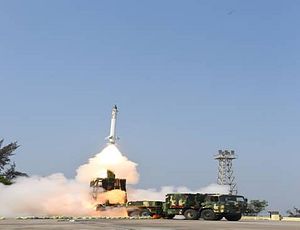India has successfully conducted a flight test of its indigenously designed Advanced Air Defense (AAD)/ Ashvin Advanced Defense interceptor missile on Abdul Kalam Island off the coast of Odisha in the Bay of Bengal, home to the Indian military’s primary missile test facility, the so-called Integrated Test Range, on March 1, according to the Indian Ministry of Defense (MoD).
The missile test was overseen by the Defence Research Development Organisation (DRDO), the MoD’s research and development wing. The test firing from a mobile missile launcher occurred at 10:15 a.m. local time. According to the MoD, the missile interceptor destroyed the incoming target with a direct hit at an altitude of 15 kilometers. “All the mission objectives were successfully met,” the statement reads.
Like during previous tests, the target simulating an incoming ballistic missile was presumably launched from an Indian warship in the Bay of Bengal.
“The weapon system radars tracked the target and provided the initial guidance to the interceptor which could precisely home on to the target and destroyed it in endo-atmospheric layer,” the statement continues. “The complete event including the engagement and destruction was tracked by a number of electro-optical tracking systems using infrared imagery. Radars and telemetry stations tracked the target and the interceptor till the destruction of the target.”
As I explained elsewhere, the single stage solid rocket propelled AAD/Ashin interceptor missile is part of a two-layered ballistic missile defense (BMD) system:
Following the end of the Kargil War and in reaction to China and Pakistan’s growing missile arsenals, India has been working since 1999 on a two-tiered ballistic missile defense system with the PAD [Prithvi Air Defense] and PDV [Prithvi Defense Vehicle] designed to destroy missiles at exo-atmospheric altitudes of 50–150 kilometers (some sources say 180 kilometers) and the Advanced Air Defense (AAD)/ Ashvin Advanced Defense interceptor missile endo-atmosphere at altitudes of 20-40 kilometers.
The BMD system can allegedly intercept medium range ballistic missiles traveling at speeds of Mach 3 to Mach 8. PAD and PDV are designed for mid-course interception, whereas AAD is a terminal phase interception system capable of intercepting missiles after they enter the earth’s atmosphere.
As I reported last month, India also successfully conducted a test of the new PDV exo-atmospheric interceptor missile slated to replace the existing Prithvi Air Defense (PAD)/Pradyumna Ballistic Missile Interceptor. “Among other things, the new two-stage solid-fueled PDV interceptor is fitted with an Imaging Infrared (IIR) seeker, developed by DRDO, to distinguish between incoming warheads and decoys,” I explained.
India last test fired the Ashvin interceptor from a mobile launcher in May 2016, where it successfully destroyed an incoming Dhanush ballistic missile, the naval variant of the Prithyi III tactical surface-to-surface short-range ballistic missile with a range of 350 kilometers (217 miles), at endo-atmospheric altitudes. Like previous tests, the March 1 missile launch will likely lead to strong condemnation from Pakistan, which in January test fired a new medium range ballistic missile purportedly capable of carrying multiple warheads using Multiple Independently Targetable Reentry Vehicle (MIRV) technology.

































